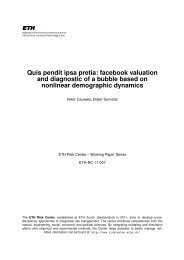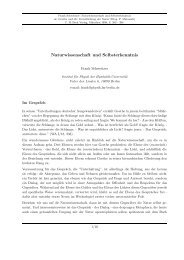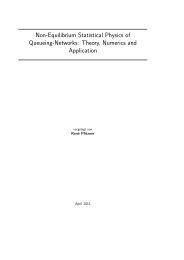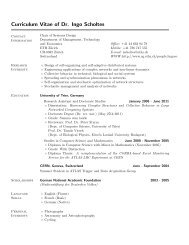Using Laboratory Experiments to Study Law and Crime - Chair of ...
Using Laboratory Experiments to Study Law and Crime - Chair of ...
Using Laboratory Experiments to Study Law and Crime - Chair of ...
Create successful ePaper yourself
Turn your PDF publications into a flip-book with our unique Google optimized e-Paper software.
In their first experiment, McAdams <strong>and</strong> Nadler have participants play a “Hawk-Dove”game – basically a game <strong>of</strong> chicken. This game includes both elements <strong>of</strong> coordination <strong>and</strong>conflict. There are two players, each <strong>of</strong> whom can choose between one <strong>of</strong> two strategies – hawk(be aggressive) or dove (be a chicken). The highest pay<strong>of</strong>f goes <strong>to</strong> the person who is aggressive(hawk) when the other person is a chicken (dove). The next highest pay<strong>of</strong>f occurs when bothplayers choose dove. The worst outcome for both occurs when they both decide <strong>to</strong> be aggressive.In this situation there is conflict – each person would prefer <strong>to</strong> choose hawk when theother chooses dove. But, both <strong>of</strong> them view the hawk-hawk combination as the worst possibleoutcome. They both want <strong>to</strong> avoid this outcome <strong>and</strong> therefore have a reason <strong>to</strong> coordinate. Howdo they know whether <strong>to</strong> choose hawk or dove?McAdams <strong>and</strong> Nadler (2005) compared several conditions: control, ostension (spinner),intentionality (leader), <strong>and</strong> legitimacy (leader selected by merit). In the control condition, noexpressive information was provided. In the spinner condition, the experimenters used a spinner<strong>to</strong> highlight one outcome. In the leader condition, one <strong>of</strong> the participants was r<strong>and</strong>omly selected<strong>to</strong> act as leader <strong>and</strong> <strong>to</strong> write a strategy on the board. Finally in the merit-based leader condition,participants <strong>to</strong>ok a quiz. Those with the highest quiz scores served as leaders who identified astrategy.McAdams <strong>and</strong> Nadler looked <strong>to</strong> see whether the highlighted outcome (the focal strategy)affected subjects’ choices. In the control condition, 51% <strong>of</strong> subjects chose one outcome, theother 49% chose the other. In the spinner condition, 65% <strong>of</strong> subjects conformed with the spinnersuggestion. In the r<strong>and</strong>om leader condition, 74% conformed. And in the merit based leader 76%conformed with the leader’s suggestion. Analyses showed that the experimental conditionsaffected behavior. In the spinner, leader, <strong>and</strong> merit-based leader conditions, the majority <strong>of</strong>subjects followed the suggestion. Further, subjects followed the suggestion more when it wasmade by a leader (as in the leader <strong>and</strong> merit-based leader conditions) than when it was made by aspinner.22







